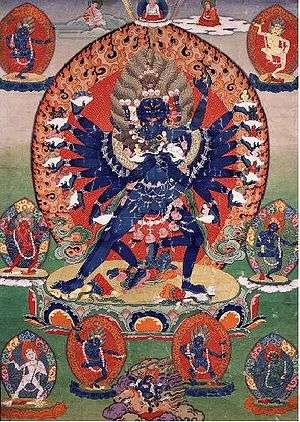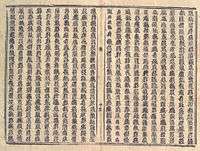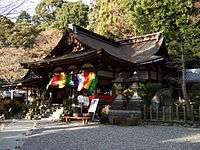Vajrayana
| Part of a series on |
| Vajrayana Buddhism |
|---|
 |
|
Traditions Historical traditions:
New branches:
|
|
History |
|
Pursuit |
|
Practices |
|
Festivals |
|
Ordination and transmission |
| Vajrayana Buddhism portal |
Vajrayāna (Sanskrit: वज्रयान, literally meaning either the Diamond Vehicle or Thunderbolt Vehicle) is the tantric corpus of Buddhism.
According to Vajrayāna scriptures, the term Vajrayāna refers to one of three vehicles or routes to enlightenment, the other two being the Śrāvakayāna (also known as the Hīnayāna) and Mahāyāna.
Founded by Indian Mahāsiddhas, Vajrayāna subscribes to Buddhist tantric literature.[1]
History of Vajrayāna in India
Influence of Saivism
Various classes of Vajrayana literature developed as a result of royal courts sponsoring both Buddhism and Saivism.[2] The Mañjusrimulakalpa, which later came to be classified under Kriyatantra, states that mantras taught in the Shaiva, Garuda and Vaishnava tantras will be effective if applied by Buddhists since they were all taught originally by Manjushri.[3] The Guhyasiddhi of Padmavajra, a work associated with the Guhyasamaja tradition, prescribes acting as a Shaiva guru and initiating members into Saiva Siddhanta scriptures and mandalas.[4] The Samvara tantra texts adopted the pitha list from the Shaiva text Tantrasadbhava, introducing a copying error where a deity was mistaken for a place.[5]
Sahaja-siddhis and Kalacakra tantra
The Vajrayana established the symbolic terminology and the liturgy that would characterize all forms of the tradition.[6]
The sahaja-siddhi movement developed in the 8th century in Bengal.[7] It was dominated by long-haired, wandering siddhas who openly challenged and ridiculed the Buddhist establishment.[6]
The Kalachakra tantra developed in the 10th century.[8] It is farthest removed from the earlier Buddhist traditions, and incorporates concepts of messianism and astrology not present elsewhere in Buddhist literature.[6]
Place within Buddhist tradition
Various classifications are possible when distinguishing Vajrayana from the other Buddhist traditions. Vajrayana can be seen as a third yana, next to Hinayana and Mahayana.[6] Vajrayana can be distinguished from the Sutrayana. The Sutrayana is the method of perfecting good qualities, where the Vajrayāna is the method of taking the intended outcome of Buddhahood as the path. Vajrayana, belonging to the mantrayana, can also be distinguished from the paramitayana. According to this schema, Indian Mahayana revealed two vehicles (yana) or methods for attaining enlightenment: the method of the perfections (Paramitayana) and the method of mantra (Mantrayana).[9] The Paramitayana consists of the six or ten paramitas, of which the scriptures say that it takes three incalculable aeons to lead one to Buddhahood. The tantra literature, however, claims that the Mantrayana leads one to Buddhahood in a single lifetime.[9] According to the literature, the mantra is an easy path without the difficulties innate to the Paramitayana.[9] Mantrayana is sometimes portrayed as a method for those of inferior abilities.[9] However the practitioner of the mantra still has to adhere to the vows of the Bodhisattva.[9]
Philosophical background
Tibetan Buddhist Rongzom Chokyi Zangpo (1012–1088) held that the views of sutra such as Madhyamaka were inferior to that of tantra, as Koppl notes:
By now we have seen that Rongzom regards the views of the Sutrayana as inferior to those of Mantra, and he underscores his commitment to the purity of all phenomena by criticizing the Madhyamaka objectification of the authentic relative truth.[10]
Characteristics of Vajrayana
Goal
The goal of spiritual practice within the Mahayana and Vajrayana traditions is to become a Bodhisattva (i.e. attainment of a state in which one will subsequently become a Buddha—after some further reincarnation), whereas the goal for Theravada practice is specific to become an arhat (i.e. attain enlightenment with no intention of returning, not even as a Buddha).
In the Sutrayana practice, a path of Mahayana, the "path of the cause" is taken, whereby a practitioner starts with his or her potential Buddha-nature and nurtures it to produce the fruit of Buddhahood. In the Vajrayana the "path of the fruit" is taken whereby the practitioner takes his or her innate Buddha-nature as the means of practice. The premise is that since we innately have an enlightened mind, practicing seeing the world in terms of ultimate truth can help us to attain our full Buddha-nature.[11]
Experiencing ultimate truth is said to be the purpose of all the various tantric techniques practiced in the Vajrayana. Apart from the advanced meditation practices such as Mahamudra and Dzogchen, which aim to experience śūnyatā, the empty nature of the enlightened mind that can see ultimate truth, all practices are aimed in some way at purifying the impure perception of the practitioner to allow ultimate truth to be seen. These may be ngöndro "preliminary practices" or the more advanced techniques of the tantric sādhanā.
Motivation
As with the Mahayana, motivation is a vital component of Vajrayana practice. The Bodhisattva-path is an integral part of the Vajrayana, which teaches that all practices are to be undertaken with the motivation to achieve Buddhahood for the benefit of all sentient beings.
Ritual
The distinctive feature of Vajrayana Buddhism is ritual, which is used as a substitute or alternative for the earlier abstract meditations.[12][13] For Vajrayana Tibetan death rituals, see phowa.
Upaya
The Vajrayana is based on the concept of "skilful means" (Sanskrit: upaya) as formulated in Mahayana Buddhism. It is a system of lineages, whereby those who successfully receive an empowerment or sometimes called initiation (permission to practice) are seen to share in the mindstream of the realisation of a particular skillful means of the vajra Master. In the Vajrayana these skilful means mainly relate to tantric, Mahamudra or Dzogchen practices. Vajrayana teaches that the Vajrayana techniques provide an accelerated path to enlightenment.
Esoteric transmission
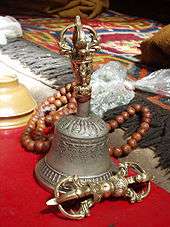
Vajrayana Buddhism is esoteric in the sense that the transmission of certain teachings only occurs directly from teacher to student during an empowerment and cannot be simply learned from a book. Many techniques are also commonly said to be secret, but some Vajrayana teachers have responded that secrecy itself is not important and only a side-effect of the reality that the techniques have no validity outside the teacher-student lineage.[14] In order to engage in Vajrayana practice, a student should have received such an initiation or permission:
If these techniques are not practiced properly, practitioners may harm themselves physically and mentally. In order to avoid these dangers, the practice is kept "secret" outside the teacher/student relationship. Secrecy and the commitment of the student to the vajra guru are aspects of the samaya (Tib. damtsig), or "sacred bond", that protects both the practitioner and the integrity of the teachings."[15]
The teachings may also be considered "self-secret", meaning that even if they were to be told directly to a person, that person would not necessarily understand the teachings without proper context. In this way the teachings are "secret" to the minds of those who are not following the path with more than a simple sense of curiosity.[16][17]
Vows and behaviour
Practitioners of the Vajrayana need to abide by various tantric vows or samaya of behaviour. These are extensions of the rules of the Prātimokṣa and Bodhisattva vows for the lower levels of tantra, and are taken during initiations into the empowerment for a particular Anuttarayoga Tantra. The special tantric vows vary depending on the specific mandala practice for which the initiation is received, and also depending on the level of initiation. Ngagpas of the Nyingma school keep a special non-celibate ordination.
A tantric guru, or teacher, is expected to keep his or her samaya vows in the same way as his students. Proper conduct is considered especially necessary for a qualified Vajrayana guru. For example, the Ornament for the Essence of Manjushrikirti states:[18]
Distance yourself from Vajra Masters who are not keeping the three vows
who keep on with a root downfall, who are miserly with the Dharma,
and who engage in actions that should be forsaken.
Those who worship them go to hell and so on as a result.
Tantra techniques
Symbols and imagery

The Vajrayana uses a rich variety of symbols and images.
The Vajra
The Sanskrit term "vajra" denoted the thunderbolt, a legendary weapon and divine attribute that was made from an adamantine, or indestructible, substance and which could therefore pierce and penetrate any obstacle or obfuscation. It is the weapon of choice of Indra, the King of the Devas in Hinduism. As a secondary meaning, "vajra" refers to this indestructible substance, and so is sometimes translated as "adamantine" or "diamond". So the Vajrayana is sometimes rendered in English as "The Adamantine Vehicle" or "The Diamond Vehicle".
A vajra is also a scepter-like ritual object (Standard Tibetan: རྡོ་རྗེ་ dorje), which has a sphere (and sometimes a gankyil) at its centre, and a variable number of spokes, 3, 5 or 9 at each end (depending on the sadhana), enfolding either end of the rod. The vajra is often traditionally employed in tantric rituals in combination with the bell or ghanta; symbolically, the vajra may represent method as well as great bliss and the bell stands for wisdom, specifically the wisdom realizing emptiness.
Imagery and ritual in deity yoga
Representations of the deity, such as statues (murti), paintings (thangka), or mandala, are often employed as an aid to visualization, in Deity yoga. Mandalas are sacred enclosures, sacred architecture that house and contain the uncontainable essence of a yidam. In the book The World of Tibetan Buddhism, the Dalai Lama describes mandalas thus: "This is the celestial mansion, the pure residence of the deity."
All ritual in Vajrayana practice can be seen as aiding in this process of visualization and identification. The practitioner can use various hand implements such as a vajra, bell, hand-drum (damaru) or a ritual dagger (phurba), but also ritual hand gestures (mudras) can be made, special chanting techniques can be used, and in elaborate offering rituals or initiations, many more ritual implements and tools are used, each with an elaborate symbolic meaning to create a special environment for practice. Vajrayana has thus become a major inspiration in traditional Tibetan art.
Vajrayana textual tradition
The Vajrayana tradition has developed an extended body of texts:
Though we do not know precisely at present just how many Indian tantric Buddhist texts survive today in the language in which they were written, their number is certainly over one thousand five hundred; I suspect indeed over two thousand. A large part of this body of texts has also been translated into Tibetan, and a smaller part into Chinese. Aside from these, there are perhaps another two thousand or more works that are known today only from such translations. We can be certain as well that many others are lost to us forever, in whatever form. Of the texts that survive a very small proportion has been published; an almost insignificant percentage has been edited or translated reliably.[19]
Literary characteristics
Vajrayana texts exhibit a wide range of literary characteristics—usually a mix of verse and prose, almost always in a Sanskrit that "transgresses frequently against classical norms of grammar and usage," although also occasionally in various Middle Indic dialects or elegant classical Sanskrit.[20]
Dunhuang manuscripts
The Dunhuang manuscripts also contain Tibetan Tantric manuscripts. Dalton and Schaik (2007, revised) provide an excellent online catalogue listing 350 Tibetan Tantric Manuscripts] from Dunhuang in the Stein Collection of the British Library which is currently fully accessible online in discrete digitized manuscripts.[web 1] With the Wylie transcription of the manuscripts they are to be made discoverable online in the future.[21] These 350 texts are just a small portion of the vast cache of the Dunhuang manuscripts.
Schools of Vajrayana
Although there is historical evidence for Vajrayana Buddhism in Southeast Asia and elsewhere (see History of Vajrayana above), today the Vajrayana exists primarily in the form of the two major traditions of Tibetan Buddhism and Japanese Esoteric Buddhism in Japan known as Shingon (literally "True Speech", i.e. mantra), with a handful of minor subschools utilising lesser amounts of esoteric or tantric materials.
The distinction between traditions is not always rigid. For example, the tantra sections of the Tibetan Buddhist canon of texts sometimes include material not usually thought of as tantric outside the Tibetan Buddhist tradition, such as the Heart Sutra[22] and even versions of some material found in the Pali Canon.[23][lower-alpha 1]
Tibetan Buddhism
.jpg)
The Tibetan Buddhist schools, based on the lineages and textual traditions of the Kangyur and Tengyur of Tibet, are found in Tibet, Bhutan, northern India, Nepal, southwestern and northern China, Mongolia and various constituent republics of Russia that are adjacent to the area, such as Amur Oblast, Buryatia, Chita Oblast, the Tuva Republic and Khabarovsk Krai. Tibetan Buddhism is also the main religion in Kalmykia.
Vajrayana Buddhism was established in Tibet in the 8th century when Śāntarakṣita was brought to Tibet from India at the instigation of the Dharma King Trisong Detsen, some time before 767.
Nepalese Newar Buddhism
Newar Buddhism is practiced by Newars in Nepal. This is the only form of Vajrayana Buddhism in which the scriptures are written in Sanskrit. Its priests do not follow celibacy and are called vajracharya (literally "diamond-thunderbolt carriers").
Burmese Ari Buddhism
Ari Buddhism was common in Burma, prior to Anawrahta's rise and the subsequent conversion to Theravada Buddhism in the 11th century.
Bai Azhaliism
Azhaliism (Chinese: 阿吒力教 Āzhālìjiào) is an Esoteric Buddhist religion practiced among the Bai people of China.[24][25]
Chinese Esoteric Buddhism

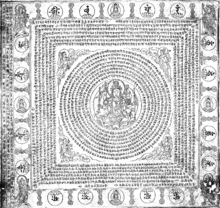
Esoteric teachings followed the same route into northern China as Buddhism itself, arriving via the Silk Road sometime during the first half of the 7th century, during the Tang dynasty, just as Buddhism was reaching its zenith in China, and received sanction from the emperors of the Tang dynasty. During this time, three great masters came from India to China: Śubhakarasiṃha, Vajrabodhi, and Amoghavajra. These three masters brought the esoteric teachings to their height of popularity in China.[26] During this era, the two main source texts were the Mahāvairocana Abhisaṃbodhi Tantra, and the Tattvasaṃgraha Tantra. Traditions in the Sinosphere still exist for these teachings, and they more or less share the same doctrines as Shingon, with many of its students themselves traveling to Japan to be given transmission at Mount Koya.
Esoteric methods were naturally incorporated into Chinese Buddhism during the Tang dynasty. Śubhakarasiṃha's most eminent disciple, Master Yixing (Ch. 一行), was a member of the Chán school. In such a way, in Chinese Buddhism there was no major distinction between exoteric and esoteric practices, and the northern school of Chán Buddhism even became known for its esoteric practices of dhāraṇīs and mantras.[27][28]
The practice of Tantric Buddhism in Western Xia led to the spread of some sexually related customs. Before they could get married to men of their own ethnicity when they reached 30 years old, Uighur women in Shanxi in the 12th century had children after having sex with multiple Han Chinese men, with her desirability as a wife corresponding to if she had been with a large number of men.[29][30][31]
During the Yuan dynasty, the Mongol emperors made Esoteric Buddhism the official religion of China, and Tibetan lamas were given patronage at the court.[32] A common perception was that this patronage of lamas caused corrupt forms of tantra to become widespread.[32] When the Mongol Yuan dynasty was overthrown and the Ming dynasty was established, the Tibetan lamas were expelled from the court, and this form of Buddhism was denounced as not being an orthodox path.[32]
In late imperial China, the early traditions of Esoteric Buddhism were still thriving in Buddhist communities. Robert Gimello has also observed that in these communities, the esoteric practices associated with Cundī were extremely popular among both the populace and the elite.[33]
In China and countries with large Chinese populations such as Taiwan, Malaysia, and Singapore, Esoteric Buddhism is most commonly referred to with the Chinese term Mìzōng (密宗), literally "Esoteric Tradition" or "Mystery Tradition". Traditions of specifically Chinese Esoteric Buddhism are most commonly referred to as Tángmì (唐密), "Tang Esotericism" or "Tang Mysteries", or Hànchuán Mìzōng (漢傳密宗), "Han Transmission of the Esoteric Tradition" (Hànmì 漢密, "Han Mysteries", for short), or even Dōngmì (東密), "Eastern Esotericism" or "Eastern Mysteries", separating itself from Tibetan and Newar traditions. These schools more or less share the same doctrines as Shingon. There is an ongoing revival of Tangmi or Hanmi in contemporary China.[34] [35]
Japan
Shingon Buddhism
The Shingon school is found in Japan and includes practices, known in Japan as Mikkyō ("Esoteric (or Mystery) Teaching"), which are similar in concept to those in Vajrayana Buddhism. The lineage for Shingon Buddhism differs from that of Tibetan Vajrayana, having emerged from India during the 9th-11th centuries in the Pala Dynasty and Central Asia (via China) and is based on earlier versions of the Indian texts than the Tibetan lineage. Shingon shares material with Tibetan Buddhism–-such as the esoteric sutras (called Tantras in Tibetan Buddhism) and mandalas – but the actual practices are not related. The primary texts of Shingon Buddhism are the Mahavairocana Sutra and Vajrasekhara Sutra. The founder of Shingon Buddhism was Kukai, a Japanese monk who studied in China in the 9th century during the Tang dynasty and brought back Vajrayana scriptures, techniques and mandalas then popular in China. The school mostly died out or was merged into other schools in China towards the end of the Tang dynasty but flourished in Japan. Shingon is one of the few remaining branches of Buddhism in the world that continues to use the siddham script of the Sanskrit language.
Tendai Buddhism
Although the Tendai school in China and Japan does employ some esoteric practices, these rituals came to be considered of equal importance with the exoteric teachings of the Lotus Sutra. By chanting mantras, maintaining mudras, or practicing certain forms of meditation, Tendai maintains that one is able to understand sense experiences as taught by the Buddha, have faith that one is innately an enlightened being, and that one can attain enlightenment within the current lifetime.
Shugendō
Shugendō was founded in 7th century Japan by the ascetic En no Gyōja, based on the Queen's Peacocks Sutra. With its origins in the solitary hijiri back in the 7th century, Shugendō evolved as a sort of amalgamation between Esoteric Buddhism, Shinto and several other religious influences including Taoism. Buddhism and Shinto were amalgamated in the shinbutsu shūgō, and Kūkai's syncretic religion held wide sway up until the end of the Edo period, coexisting with Shinto elements within Shugendō[36]
In 1613 during the Edo period, the Tokugawa Shogunate issued a regulation obliging Shugendō temples to belong to either Shingon or Tendai temples. During the Meiji Restoration, when Shinto was declared an independent state religion separate from Buddhism, Shugendō was banned as a superstition not fit for a new, enlightened Japan. Some Shugendō temples converted themselves into various officially approved Shintō denominations. In modern times, Shugendō is practiced mainly by Tendai and Shingon sects, retaining an influence on modern Japanese religion and culture.[37]
Academic study difficulties
Serious Vajrayana academic study in the Western world is in early stages due to the following obstacles:[38]
- Although a large number of Tantric scriptures are extant, they have not been formally ordered or systematized.
- Due to the esoteric initiatory nature of the tradition, many practitioners will not divulge information or sources of their information.
- As with many different subjects, it must be studied in context and with a long history spanning many different cultures.
- Ritual as well as doctrine need to be investigated.
Buddhist tantric practice are categorized as secret practice; this is to avoid misinformed people from harmfully misusing the practices. A method to keep this secrecy is that tantric initiation is required from a master before any instructions can be received about the actual practice. During the initiation procedure in the highest class of tantra (such as the Kalachakra), students must take the tantric vows which commit them to such secrecy.[web 2] "Explaining general tantra theory in a scholarly manner, not sufficient for practice, is likewise not a root downfall. Nevertheless, it weakens the effectiveness of our tantric practice." [web 3]
Terminology
The terminology associated with Vajrayana Buddhism can be confusing. Most of the terms originated in the Sanskrit language of tantric Indian Buddhism and may have passed through other cultures, notably those of Japan and Tibet, before translation for the modern reader. Further complications arise as seemingly equivalent terms can have subtle variations in use and meaning according to context, the time and place of use. A third problem is that the Vajrayana texts employ the tantric tradition of twilight language, a means of instruction that is deliberately coded. These obscure teaching methods relying on symbolism as well as synonym, metaphor and word association add to the difficulties faced by those attempting to understand Vajrayana Buddhism:
In the Vajrayana tradition, now preserved mainly in Tibetan lineages, it has long been recognized that certain important teachings are expressed in a form of secret symbolic language known as saṃdhyā-bhāṣā, 'Twilight Language'. Mudrās and mantras, maṇḍalas and cakras, those mysterious devices and diagrams that were so much in vogue in the pseudo-Buddhist hippie culture of the 1960s, were all examples of Twilight Language [...] [39]
The term Tantric Buddhism was not one originally used by those who practiced it. As scholar Isabelle Onians explains:
"Tantric Buddhism" [...] is not the transcription of a native term, but a rather modern coinage, if not totally occidental. For the equivalent Sanskrit tāntrika is found, but not in Buddhist texts. Tāntrika is a term denoting someone who follows the teachings of scriptures known as Tantras, but only in Saivism, not Buddhism [...] Tantric Buddhism is a name for a phenomenon which calls itself, in Sanskrit, Mantranaya, Vajrayāna, Mantrayāna or Mantramahāyāna (and apparently never Tantrayāna). Its practitioners are known as mantrins, yogis, or sādhakas. Thus, our use of the anglicised adjective “Tantric” for the Buddhist religion taught in Tantras is not native to the tradition, but is a borrowed term which serves its purpose.[40]
See also
- Buddhism in Bhutan
- Buddhism in the Maldives
- Buddhism in Nepal
- Buddhism in Russia
- Drukpa Lineage
- Gyuto Order
- Newar Buddhism
- Tantric Theravada
- Tawang Taktshang Monastery
- Category:Tibetan Buddhist teachers
Notes
References
- ↑ Macmillan Publishing 2004, p. 875-876.
- ↑ Sanderson, Alexis. "The Śaiva Age: The Rise and Dominance of Śaivism during the Early Medieval Period." In: Genesis and Development of Tantrism,edited by Shingo Einoo. Tokyo: Institute of Oriental Culture, University of Tokyo, 2009. Institute of Oriental Culture Special Series, 23, pp. 124.
- ↑ Sanderson, Alexis. "The Śaiva Age: The Rise and Dominance of Śaivism during the Early Medieval Period." In: Genesis and Development of Tantrism,edited by Shingo Einoo. Tokyo: Institute of Oriental Culture, University of Tokyo, 2009. Institute of Oriental Culture Special Series, 23, pp. 129-131.
- ↑ Sanderson, Alexis. "The Śaiva Age: The Rise and Dominance of Śaivism during the Early Medieval Period." In: Genesis and Development of Tantrism,edited by Shingo Einoo. Tokyo: Institute of Oriental Culture, University of Tokyo, 2009. Institute of Oriental Culture Special Series, 23, pp. 144-145.
- ↑ Huber, Toni (2008). The holy land reborn : pilgrimage & the Tibetan reinvention of Buddhist India. Chicago: University of Chicago Press. pp. 94–95. ISBN 978-0-226-35648-8.
- 1 2 3 4 Kitagawa 2002, p. 80.
- ↑ Schumann 1974, p. 163.
- ↑ Schumann 1974.
- 1 2 3 4 5 Macmillan Publishing 2004, p. 875.
- ↑ Koppl, Heidi. Establishing Appearances as Divine. Snow Lion Publications 2008, chapter 4.
- ↑ Palmo, Tenzin (2002). Reflections on a Mountain Lake:Teachings on Practical Buddhism. Snow Lion Publications. pp. 224–5. ISBN 1-55939-175-8.
- ↑ Warder 1999, p. 466.
- ↑ Hawkins 1999, p. 24.
- ↑ Dhammasaavaka. The Buddhism Primer: An Introduction to Buddhism, p. 79. ISBN 1-4116-6334-9
- ↑ Ray 2001.
- ↑ Morreale, Don (1998) The Complete Guide to Buddhist America ISBN 1-57062-270-1 p.215
- ↑ Trungpa, Chögyam and Chödzin, Sherab (1992) The Lion's Roar: An Introduction to Tantra ISBN 0-87773-654-5 p. 144.
- ↑ Tsongkhapa , Tantric Ethics: An Explanation of the Precepts for Buddhist Vajrayana Practice ISBN 0-86171-290-0, page 46.
- ↑ Isaacson, Harunaga (1998). Tantric Buddhism in India (from c. 800 to c. 1200). In: Buddhismus in Geschichte und Gegenwart. Band II. Hamburg. pp.23–49. (Internal publication of Hamburg University.) pg 3 PDF
- ↑ Isaacson
- ↑ Dalton, Jacob & van Schaik, Sam (2007). Catalogue of the Tibetan Tantric Manuscripts from Dunhuang in the Stein Collection [Online]. Second electronic edition. International Dunhuang Project. Source: (accessed: Tuesday February 2, 2010)
- ↑ Conze, The Prajnaparamita Literature
- ↑ Peter Skilling, Mahasutras, volume I, 1994, Pali Text Society, Lancaster, page xxiv
- ↑ Huang, Zhengliang; Zhang, Xilu (2013). "Research Review of Bai Esoteric Buddhist Azhali Religion Since the 20th Century". Journal of Dali University.
- ↑ Wu, Jiang (2011). Enlightenment in Dispute: The Reinvention of Chan Buddhism in Seventeenth-Century China. USA: Oxford University Press. ISBN 0199895562. p. 441
- ↑ Baruah, Bibbhuti (2008) Buddhist Sects and Sectarianism: p. 170
- ↑ Sharf, Robert (2001) Coming to Terms With Chinese Buddhism: A Reading of the Treasure Store Treatise: p. 268
- ↑ Faure, Bernard (1997) The Will to Orthodoxy: A Critical Genealogy of Northern Chan Buddhism: p. 85
- ↑ Michal Biran (15 September 2005). The Empire of the Qara Khitai in Eurasian History: Between China and the Islamic World. Cambridge University Press. pp. 164–. ISBN 978-0-521-84226-6.
- ↑ Dunnell, Ruth W. (1983). Tanguts and the Tangut State of Ta Hsia. Princeton University., page 228
- ↑ 洪, 皓. 松漠紀聞.
- 1 2 3 Nan Huaijin. Basic Buddhism: Exploring Buddhism and Zen. York Beach: Samuel Weiser. 1997. p. 99.
- ↑ Jiang, Wu (2008). Enlightenment in Dispute: The Reinvention of Chan Buddhism in Seventeenth-Century China: p. 146
- ↑ Tangmi movement website
- ↑ Chinese Esoteric Buddhist School
- ↑ Miyake, Hitoshi. Shugendo in History. pp45–52.
- ↑ 密教と修験道
- ↑ Akira 1993, p. 9.
- ↑ Bucknell, Roderick & Stuart-Fox, Martin (1986). The Twilight Language: Explorations in Buddhist Meditation and Symbolism. Curzon Press: London. ISBN 0-312-82540-4.
- ↑ Isabelle Onians, "Tantric Buddhist Apologetics, or Antinomianism as a Norm," D.Phil. dissertation, Oxford, Trinity Term 2001 pg 8
Web references
Sources
- Akira, Hirakawa (1993), Paul Groner, ed., History of Indian Buddhism, Translated by Paul Groner, Delhi: Motilal Banarsidass Publishers
- Banerjee, S. C. (1977), Tantra in Bengal: A Study in Its Origin, Development and Influence, Manohar, ISBN 81-85425-63-9
- Buswell, Robert E., ed. (2004), Encyclopedia of Buddhism, Macmillan Reference USA, ISBN 0-02-865910-4
- Datta, Amaresh (2006), The Encyclopaedia Of Indian Literature (Volume One (A To Devo), Volume 1, Sahitya Akademi publications, ISBN 978-81-260-1803-1
- Harding, Sarah (1996), Creation and Completion - Essential Points of Tantric Meditation, Boston: Wisdom Publications
- Hawkins, Bradley K. (1999), Buddhism, Routledge, ISBN 0-415-21162-X
- Hua, Hsuan; Bhikshuni Rev. Heng Chih, Bhikshuni Rev. Heng Hsien, David Rounds, Ron Epstein, et al (2003), The Shurangama Sutra - Sutra Text and Supplements with Commentary by the Venerable Master Hsuan Hua, Burlingame, California: Buddhist Text Translation Society, ISBN 0-88139-949-3, archived from the original on May 29, 2009 Cite uses deprecated parameter
|coauthors=(help) - Kitagawa, Joseph Mitsuo (2002), The Religious Traditions of Asia: Religion, History, and Culture, Routledge, ISBN 0-7007-1762-5
- Mishra, Baba; Dandasena, P.K. (2011), Settlement and urbanization in ancient Orissa
- Patrul Rinpoche (1994), Brown, Kerry; Sharma, Sima, eds., The Words of My Perfect Teacher (Tibetan title: kunzang lama'i shelung). Translated by the Padmakara Translation Group. With a forward by the Dalai Lama, San Francisco, California, USA: HarperCollinsPublishers, ISBN 0-06-066449-5
- Ray, Reginald A (2001), Secret of the Vajra World: The Tantric Buddhism of Tibet, Boston: Shambhala Publications
- Schumann, Hans Wolfgang (1974), Buddhism: an outline of its teachings and schools, Theosophical Pub. House
- Snelling, John (1987), The Buddhist handbook. A Complete Guide to Buddhist Teaching and Practice, London: Century Paperbacks
- Wardner, A.K. (1999), Indian Buddhism, Delhi: Motilal Banarsidass Publishers
- Williams, Paul; Tribe, Anthony (2000), Buddhist Thought: A complete introduction to the Indian tradition, Routledge, ISBN 0-203-18593-5
Further reading
- Rongzom Chözang; Köppl, Heidi I. (trans) (2008). Establishing Appearances as Divine. Snow Lion. pp. 95–108. ISBN 9781559392884.
- Kongtrul, Jamgon; Thrangu Rinpoche; Harding, Sarah (2002). Creation and Completion: Essential Points of Tantric Meditation. Wisdom Publications. ISBN 0-86171-312-5.
- Kongtrul, Jamgon; Barron, Richard (1998). Buddhist Ethics. The Treasury of Knowledge (book 5). Ithaca: Snow Lion. pp. 215–306. ISBN 1-55939-191-X.
- Kongtrul, Jamgon; Guarisco, Elio; McLeod, Ingrid (2004). Systems of Buddhist Tantra:The Indestructible Way of Secret Mantra. The Treasury of Knowledge (book 6 part 4). Ithaca: Snow Lion. ISBN 9781559392105.
- Kongtrul, Jamgon; Guarisco, Elio; McLeod, Ingrid (2008). The Elements of Tantric Practice:A General Exposition of the Process of Meditation in the Indestructible Way of Secret Mantra. The Treasury of Knowledge (book 8 part 3). Ithaca: Snow Lion. ISBN 9781559393058.
- Kongtrul, Jamgon; Harding, Sarah (2007). Esoteric Instructions: A Detailed Presentation of the Process of Meditation in Vajrayana. The Treasury of Knowledge (book 8 part 4). Ithaca, NY: Snow Lion Publications. ISBN 1-55939-284-3.
- Kongtrul, Jamgon; Barron, Richard (2010). Journey and Goal: An Analysis of the Spiritual Paths and Levels to be Traversed and the Consummate Fruition state. The Treasury of Knowledge (books 9 & 10). Ithaca, NY: Snow Lion Publications. pp. 159–251, 333–451. ISBN 1-55939-360-2.
- Tantric Ethics: An Explanation of the Precepts for Buddhist Vajrayana Practice by Tson-Kha-Pa, ISBN 0-86171-290-0
- Perfect Conduct: Ascertaining the Three Vows by Ngari Panchen, Dudjom Rinpoche, ISBN 0-86171-083-5
- Āryadeva's Lamp that Integrates the Practices (Caryāmelāpakapradīpa): The Gradual Path of Vajrayāna Buddhism according to the Esoteric Community Noble Tradition, ed. and trans by Christian K. Wedemeyer (New York: AIBS/Columbia Univ. Press, 2007). ISBN 978-0-9753734-5-3
- S. C. Banerji, Tantra in Bengal: A Study of Its Origin, Development and Influence, Manohar (1977) (2nd ed. 1992). ISBN 8185425639
- Arnold, Edward A. on behalf of Namgyal Monastery Institute of Buddhist Studies, fore. by Robert A. F. Thurman. As Long As Space Endures: Essays on the Kalacakra Tantra in Honor of H.H. the Dalai Lama, Snow Lion Publications, 2009.
- Snellgrove, David L.: Indo-Tibetan Buddhism. Indian Buddhists and Their Tibetan Successors. London: Serindia, 1987.
External links
| Wikiversity has learning materials about Vajrayāna |
